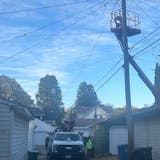The memory of the woozy woman slumped in her wheelchair still gets to Sandy McGurran, coordinator of integrative therapies for Fairview Homecare and Hospice.
McGurran was doing a home visit with the patient, who was recovering from a stroke and gagging from nausea.
"I asked her if she'd be interested in trying some aromatherapy," McGurran recalled.
The patient agreed, so McGurran dabbed a cotton ball with peppermint oil and told her to inhale like she was smelling a flower and exhale like she was blowing out a candle.
A few minutes later, the woman sat up, looked at her husband and said: "You have to get some of this tonight."
Essential oils are a hot item in today's holistic healing world — touted as a natural way to improve your mood, ward off sickness and treat ailments such as arthritis, dry skin and allergies.
Now, a growing number of hospitals are jumping onto the essential-oils bandwagon, offering them to patients to help manage pain, nausea and anxiety.
"It really is in every health care system," McGurran said. "We have clinicians who are very engaged in using aromatherapies because we see the outcomes."

